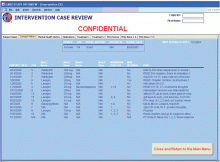The Bypassing the Blues trial: Collaborative care for post-CABG depression and implications for future research
ABSTRACTDepressive symptoms are reported by up to one-half of patients following coronary artery bypass graft (CABG) surgery, and are associated with numerous adverse outcomes, including poorer health-related quality of life, worse functional status, and delayed recovery. Strategies to detect and then manage depression in CABG patients and in cardiac populations are of great interest given the potential for depression treatment to reduce cardiovascular morbidity. Yet, many tested interventions have had little or no effect on mood symptoms in cardiac patients. “Collaborative care” is a safe and proven-effective strategy for treating depression in concert with patients’ primary care physicians; however, it had not been tested previously in patients with cardiac disease. This article presents the design and main outcome findings from the National Institutes of Health–funded Bypassing the Blues study, the first trial to examine the impact of a collaborative care strategy for treating depression among patients with cardiac disease, and our efforts to improve upon and expand the model for testing in other cardiac conditions.
IDENTIFICATION OF DEPRESSION
Applying the two-step Patient Health Questionnaire (PHQ) depression screening strategy recently endorsed by the AHA Science Advisory,6 BtB recruited medically stable post-CABG patients prior to hospital discharge from seven Pittsburgh-area hospitals between 2004 and 2007. To support our recruitment efforts, we developed press releases, wall posters, newsletter articles, and brochures to inform physicians, hospital staff, patients and their families about the impact of depression on cardiovascular disease and our study (available for download at: www.bypassingtheblues.pitt.edu).
Study nurse-recruiters obtained patients’ signed informed consent to undergo screening with the two-item PHQ-222 (“Over the past 2 weeks have you had: little interest or pleasure in doing things or “felt down, depressed, or hopeless?”).47 We defined a positive PHQ-2 depression screen as patient endorsement of one or both of its items (90% sensitive and 69% specific for major depression among patients with cardiac disease when measured against the “goldstandard” Diagnostic Interview Schedule48).
The psychologic and physical symptoms of depression often overlap with the post-CABG state (eg, fatigue, sleeplessness) and these elevations in depressive symptoms frequently remit spontaneously. Therefore, we administered the nine-item PHQ-949 over the telephone 2 weeks following hospital discharge to confirm the PHQ-2 screen. We required that patients score at least 10 to remain protocol-eligible, a threshold that signified at least a moderate level of depressive symptoms49 and has been described as “virtually diagnostic” for depression among patients with cardiac disease (90% specific).48
ASSESSMENT AND OUTCOME MEASURES
Upon confirmation of all protocol-eligibility criteria prior to randomization, we conducted a detailed baseline telephone assessment that included the SF-3650 to determine mental (MCS) and physical (PCS) HRQoL, the 12-item Duke Activity Status Index (DASI)26 to determine disease-specific physical functioning, and the 17-item Hamilton Rating Scale for Depression (HRS-D)27 to track mood symptoms. Telephone assessors blinded as to randomization status readministered these measures at 2, 4, and 8 months’ followup and routinely inquired about any hospitalizations and mental health visits patients may have experienced since their last telephone assessment. Whenever they detected a potential “key event,” we requested a copy of relevant medical records from the hospital where the event occurred. These were then forwarded to a physician adjudication committee that was blinded as to the patient’s depression and intervention status to classify the nature of the event (cardiovascular, psychiatric, or “other”).
COLLABORATIVE CARE INTERVENTION
Following randomization, a nurse care manager telephoned each intervention patient to: (1) review his or her psychiatric history, including use of any prescription medications, herbal supplements, or alcohol to self-medicate depressive symptoms; and (2) provide education about depression, its impact on cardiac disease, and basic advice for managing the condition (eg, exercise, sleep, social contact, alcohol avoidance); and (3) assess the patient’s treatment preferences for depression.
Using a shared decision-making approach, patients then selected one or more of the following treatment options: (1) a workbook designed to impart self-management skills for managing depression51; (2) antidepressant pharmacotherapy, primarily a selective serotonin-reuptake inhibitor (SSRI) chosen according to patient preference, prior usage, and insurance coverage, but prescribed by the patient’s PCP46; (3) referral to a local mental health specialist in keeping with the patient’s insurance coverage; and (4) “watchful waiting” if the patient’s mood symptoms were only mildly elevated and he or she had no prior history of depression.
Afterward, the nurse care manager telephoned the patient approximately every other week during the acute phase of treatment to practice skills imparted through workbook assignments, monitor pharmacotherapy, promote adherence with recommended care, and suggest adjustments in treatment as applicable. Depending upon the patient’s motivation to complete workbook assignments and whether he or she accepted antidepressant pharmacotherapy, these followup contacts typically lasted 15 to 45 minutes and continued for 2 to 6 months. The patient subsequently transitioned to the “continuation phase” of treatment, during which the care manager contacted him or her less frequently until the end of our 8-month intervention.
WEEKLY CASE REVIEW
Following discussion, the clinical team typically formulated one to three treatment recommendations that the nurse conveyed to the patient via telephone. As PCPs were responsible for prescribing all medications and dosage adjustments, we conveyed pharmacologic recommendations to them via telephone or fax. PCPs could accept or reject these recommendations at their discretion. If the patient demonstrated little response, had complex psychosocial issues (eg, impending divorce), or had an uncertain diagnosis (eg, bipolar disorder), we typically recommended referral to a mental health specialist. At quarterly intervals and at the end of the 8-month intervention, we mailed the PCP a summary of the patient’s progress that included antidepressant dosages, PHQ-9 scores, and other pertinent information.46







